#inupiat
Text

James Kivetoruk Moses - Inupiat/Inupiak, (1900-1982) - untitled, depicting a woman and a man standing in front of their home.
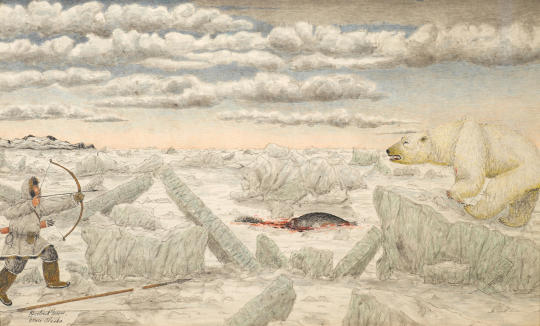
James Kivetoruk Moses - untitled, depicting a bowhunter, his seal prey, and a confronting polar bear .
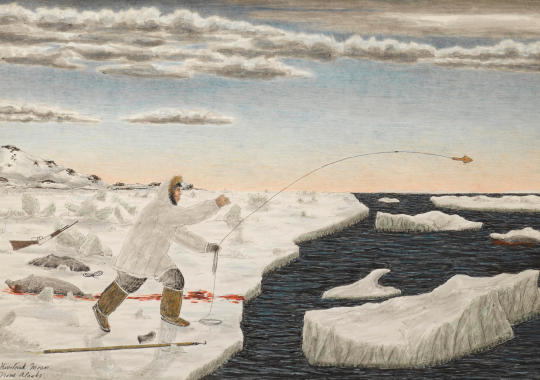
James Kivetoruk Moses - untitled, depicting a seal hunter casting his hook.
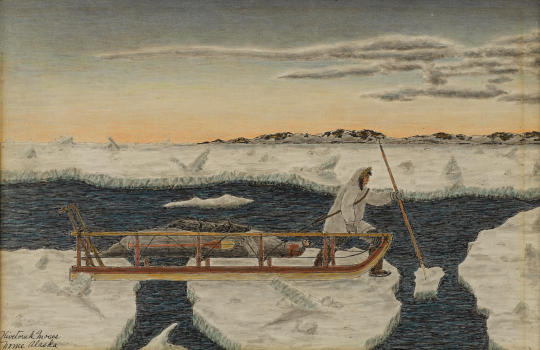
James Kivetoruk Moses - untitled, depicting a hunter with his catch working his way across ice flows.
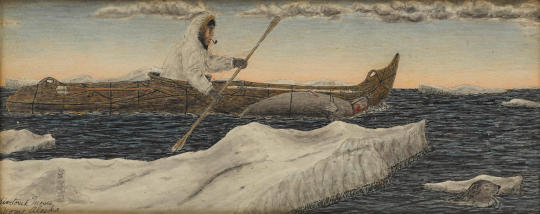
James Kivetoruk Moses - untitled, depicting a hunter in his kayak bringing in a seal.
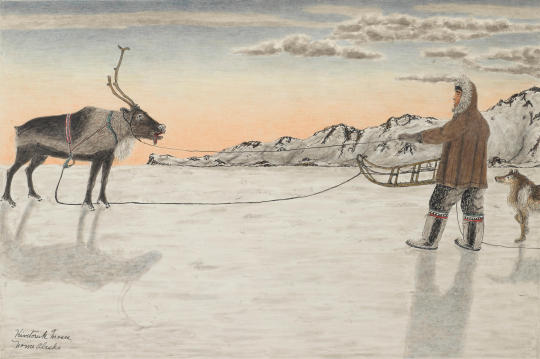
James Kivetoruk Moses - untitled, depicting a man coaxing a harnessed reindeer.

"Mr & Mrs Napasuk Big Chief East Cape Siberia", depicting a woman and a man posing in front of their camp.
When strong gusts flipped a small plane landing near Teller, on the Seward Peninsula on August 14, 1953, one 50-year-old Inupiaq Eskimo hunter, trapper, and reindeer herder injuring his leg lost all means of support. “No more work, no more hunting,” he said about the event that caused a career change. “Is only way…drawing pictures.” Recovering, James Kivetoruk Moses resumed a teenage habit now leavened by anecdotes, legends, and knowledge accrued over five decades during which the land had taught and sustained him.
At heart, he remained a herder. And modest. Asked about his pictures’ appeal, he admitted lacking refinement. “Young people try to be artists,” he said. “They come up good artists, very good drawing because they were school. But no experience. Don’t know nothing [about] living.”
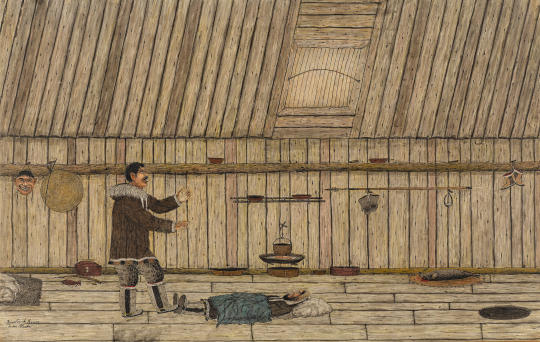
Untitled, depicting a shaman treating a sick man
In 1975, weakened by strokes and surgeries, Moses, with his wife, Bessie, resided in Nome, a non-Native commercial hub since Yankee-whaler days. Their cabin, abutting the Golden Goose saloon, sat a stone’s throw from black, foam-flecked Bering Strait beaches. Bessie, first acting as his bookkeeper, peddled a briefcase of Moses’ nostalgia at local hotels. She kept a percentage of the profits for herself, she once joked. For an extra five dollars she provided a handwritten summary of the subjects, of routines, beliefs, and a past beyond her clienteles’ ken.

Untitled, pen and ink wash on card stock
Accompanying this drawing is one of those five dollar handwritten summaries by the artist's wife Bessie, dated August 12, 1975:
"This pretty girl is from N. East Siberia. Her uncle and her folks were well to do family and they came across to our mainland from there every spring after spring to trade more than one skin or whole lot of them come same time all the way to Katzebue. They brought reindeer skins black and spotted skins, wolverines and wolfs skins to trade with all kinds of furs. This girl came with her mother because the father had to take care of their business. She was helpful and good to the people and everybody learn to love her every place. They want to help them on account of her wanting to marry. But since they were traveling the mother + father wouldn't leave her behind being the only girl. Hope the true happening is a good story. So long + good-by
By Bessie Moses"
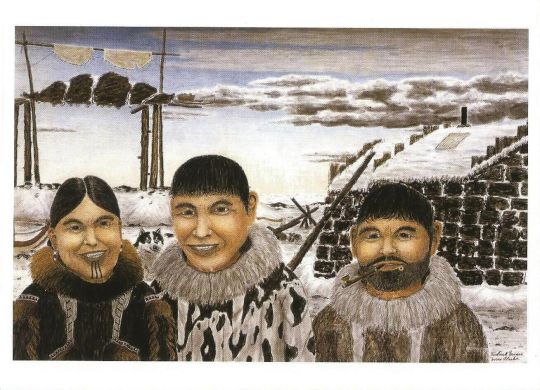
Postcard - James Kivetoruk Moses - "Eskimo Men & Woman" - Anchorage Museum
#James Kivetoruk Moses#art#artists#native american art#Inupiat#kivetoruk moses#nome alaska#alaska#bessie moses#eskimo life
110 notes
·
View notes
Text

Google sources:
The word Eskimo is an offensive term that has been used historically to describe the Inuit throughout their homeland, Inuit Nunangat, in the arctic regions of Alaska, Greenland and Canada, as well as the Yupik of Alaska and northeastern Russia, and the Inupiat of Alaska.
Strictly speaking, eskimos can also be regarded as native Americans, because what western people call ‘eskimos’ are actually the indigenous people inhabiting parts of the northern circumpolar region ranging from Siberia to parts of the Americas (Alaska and Canada). The native people of the northern polarcircle do not actually call themselves ‘Eskimos’; this is a term given to them by European settlers. The term Eskimo is regarded by many as a derogative term because it is used to describe a very large group of people with different traits and languages. Furthermore, if translated into Alonquin laguage (spoken by indigenous people in Ontario and Quebec, Canada), ‘Eskimo’ means: ‘eaters of raw meat’. Obviously, eating raw meat is not the one thing that defines the Inuit people of Canada, or ‘Inuk’ if referring to a single person of Inuit descent.
Francis Carpenter, Our Little Friends of Eskimo Land: Papik and Natsek, 1932
#vintage#1932#children's lit#book#technology#inuit#yupik#inupiat#a Yupik woman explained it to me in 2013
59 notes
·
View notes
Text
GIRL HELP anyone got sources on specifically Iñupiat tellings of Sedna/Nuliajuk's story??
I'm spiraling (heh) over True Detective Night Country's themes and their ties to arctic spirituality, but unfortunately most of my sources/knowledge come from my obsession with The Terror and are related to the Nattilik or wider Nunavut...
Also if anyone wants to read me rambling or share their own theories about this please hit me up before I end up posting on reddit jsjahdjkk
Cheers!
11 notes
·
View notes
Text
Horses: Inupiat
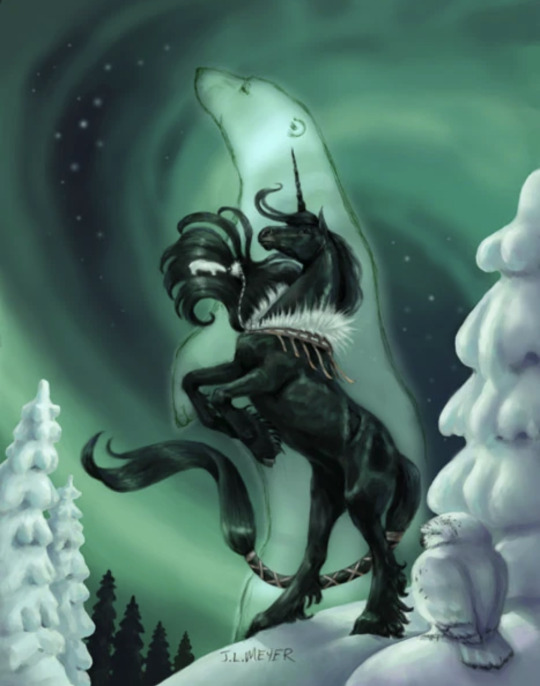
Inupiat is an adult male unicorn. He is officially part of herd Mustang. His animal friend is a polar bear. Inupiat was created by Jennifer L. Meyer.
Inupiat is a pure black stallion. His coat, hooves, mane, tail, and horn are entirely black. He has a long mane and tail with a long horn and feathering around his hooves. Part of his tail is bound by a brown/grey strap and he wears a brown harness around his neck with white feathering and beads.
Inupiat is named after the Inuit people, a tribe found in Northwest Alaska and the Bearing Strait. The name “Inuit” means “real people”.

Like most others Inupiat’s stable art follows the original art well even having a slight green shade on parts of him despite the fact under different lighting this shade would not appear. Inupiat had a regular stable which uses the Native Lights card art for the portrait.


Quote: “You have the strength and spirit to face any challenge”
Inupiat makes 2 appearances in the card series. He appears in Native Lights as a promo card in the North American release and as a base set card in the International release. Inupiat appears again in the Best of Bella Sara series using the same card art.
Bellow is the magazine Inupiat could be found in.
(This is such a mid 2000s girl magazine. The headband, side ponytails, flower necklaces. The magazine telling you how to be more likable and the girl advice. Not to mention the quizzes and best friends theming)

Other appearances:


Inupiat appears as a mini figurine for series 1 and appears in the Bellapedia.
Opinions: Inupiat makes the top 10 as one of my favorite horses. Jennifer L. Meyer makes such gorgeous horses especially unicorns. His beautiful figure coupled with the pure black is amazing. Pure unicorns are already not super common in the Bella Sara world so Inupiat being the only pure black makes him even more special.
Headcannons:
- Like the rest of hers Mustang he does not stay in one area.
- He however typically sticks to colder areas.
- He loves to travel around and help people always reassuring them that they are strong.
- He is huge
- He himself is very strong both physically and spiritually as well as magically.
- He has been invited to herd Bellasara but declined to stay with Mustang.
- His magic can summon the spirit of a polar bear and can even control the lights in the sky
- He is well known throughout all of North of North
- Some consider him a myth for how quickly he appears and disappears.
#bella sara#bellasara#horse#fantasyhorses#horses#magical horses#fantasyhorse#2000s nostalgia#herd Mustang#unicorn#black unicorn#Inupiat#Jennifer L Meyer
48 notes
·
View notes
Text
youtube
I build with Royal StarAllah about getting Knowledge Of Self in Alaska, Alaskan Land Rights For Natives, Hunger Strikes, Bob Marley Movie, Western Imperialism and Much More. For the full build hit the link in the bio or the comments underneath. Like, Subscribe and Share. Peace!
#nation of gods and earths#supreme mathematics#five percent nation#allah school in mecca#hip hop#5% nation of gods and earths#black women#father allah#black men#black people#alaska#alaska natives#inupiat#yupik#american indian#indigenous#black power#Youtube
4 notes
·
View notes
Photo
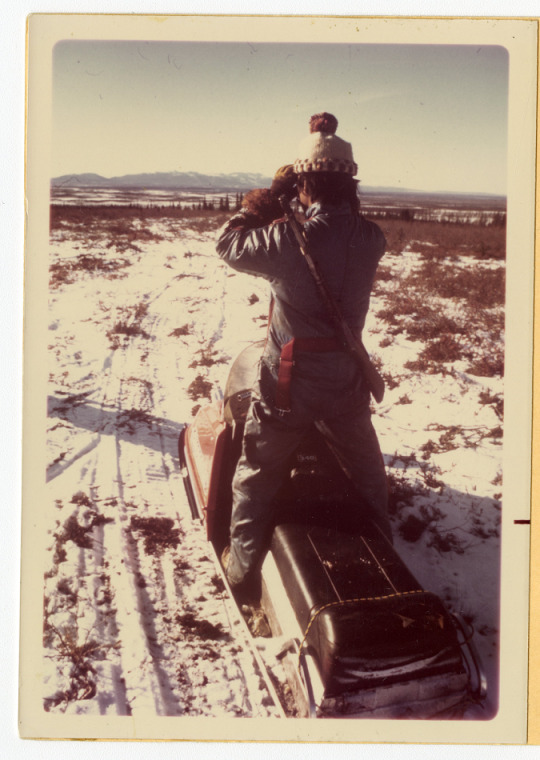

Caribou hunter in Ambler, Alaska, 45 miles north of the Arctic Circle, on 10/7/1972.
Local plants and animals are a vital food source for residents of this area.
File Unit: Ethnography and Subsistence, 1972 - 1976
Series: Alaska Task Force Photographs, 1972 - 1976
Record Group 79: Records of the National Park Service, 1785 - 2006
Image description: A man standing up on a (unmoving) snowmobile, looking through binoculars. He is wearing snow pants, a leather coat, fur-trimmed gloves, and a knit hat with a bobble. He has a rifle slung across his back. The landscape shows a couple of inches of snow on dead vegetation, with mountains in the distance.
Transcription:
KOBUK RIVER
1157-6-1122
Subsistence activities
DATE 10/7/72
NEG. FILE # [blank]
FIELD # 1157-6
ROLL # [blank]
FRAME # [blank]
SUBJECT Caribou Hunter
LOCATION Ambler, Kobuk River
CREDIT: NATIONAL PARK SERVICE PHOTOGRAPH BY Robert Belous
ALASKA TASK FORCE MASTER FILE
#archivesgov#October 7#1972#1970s#Alaska Native history#Inupiat#Native American history#American Indian history#Indigenous American history#hunting#subsistence hunting#caribou#rifle#snowmobile#Alaska
28 notes
·
View notes
Text

“King Island”
The island was once the winter home to over 200 Iñupiat (Alaskan Natives) who called themselves Aseuluk meaning “people of the sea” or Ukivokmiut (from Ukivok the village of King Island and ‘miut’ meaning “people of”).
In the mid 1900s, the Bureau of Indian Affairs closed the school on King Island and forcefully removed the children of Ukivok to go to school on mainland Alaska, leaving the elders and adults to gather the needed food for winter. Because the children were not on the island to help gather the needed food for winter, the adults and elders had no choice but to move to the mainland to make their living.
By 1970, all King Island natives had moved to mainland Alaska year-round. Even after the movement off the island, some King Islanders still return to gather subsistence foods such as walrus and seal. Although the King Islanders have moved off the island, they have kept a very distinct cultural identity, living a very similar life as they had on the island. In 2005 and 2006, the National Science Foundation funded a research project which brought a few King Island natives back to the island. Some participants had not been back to the island in 50 years. The King Island Community awaits the project’s results.
#King Island#Alaska#North America#iñupiat#inupiat#aseuluk#ukivokmiut#20th century#historical#history#people#black and white#world#portrait
3 notes
·
View notes
Text
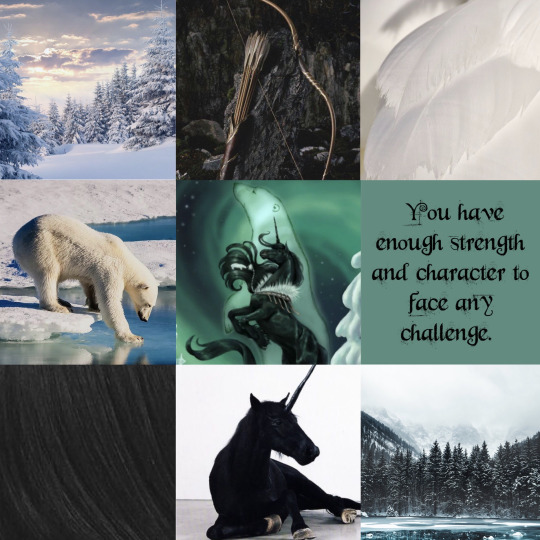
“You have enough strength and character to face any challenge.”
1 note
·
View note
Text
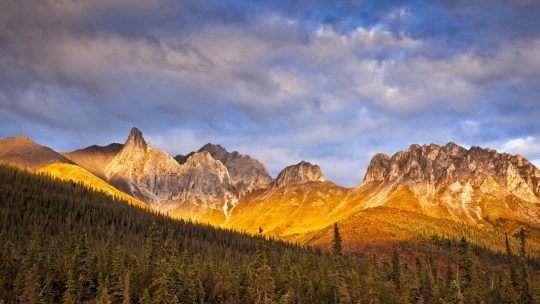
Brooks Range, Alaska by Edgar Campos
1 note
·
View note
Photo

#juniorwhaler #juniorranger #inupiat #inupiatheritagecenter #nationalpark #thenorthernmostnationalpark #polarbearterritory #endoftheland #topoftheworld #pointbarrow #northernmost #alaska #arcticocean #arctic #dreamamerica #dreamamericausa #edreamamerica #barrow #Utqiagvik #polarbear (at Barrow, Alaska) https://www.instagram.com/p/CfbwKS8LDt-/?igshid=NGJjMDIxMWI=
#juniorwhaler#juniorranger#inupiat#inupiatheritagecenter#nationalpark#thenorthernmostnationalpark#polarbearterritory#endoftheland#topoftheworld#pointbarrow#northernmost#alaska#arcticocean#arctic#dreamamerica#dreamamericausa#edreamamerica#barrow#utqiagvik#polarbear
0 notes
Text

Day 6: Ada Blackjack!
It was 1920 in Nome, Alaska, and Ada Blackjack desperately needed work. She’d been born Ada Delutuk, sent to a residency school after her father’s death, and only recently had escaped her abusive marriage, obtaining a divorce and then walking forty miles with her son in her arms. Then that son had contracting tuberculosis, and Ada had been forced to sign him over to an orphanage - with the understanding that she could reclaim him once she had money for his care. And then, opportunity knocked.
Eccentric explorer Vilhjalmur Stefansson, he of the “friendly arctic,” had hatched a bold plan. Members of his previous expedition - Stefansson not among them - had survived months marooned on lonely Wrangel Island. Perhaps a more prepared group - Stefansson, again, not among them - could colonize the island for Canada! He wanted at least one Inupiat seamstress among his hand-picked crew of scientists, likely remembering Kiruk’s aid on the previous expedition, and Ada was hired… though it came as a shock to her to find that she was the only Alaska Native on the tiny expedition: five men, herself, and Vic the cat.
By the end of the first year, the situation on barren, freezing Wrangel Island was dire. Game was sparse, and one crew member, Lorne Knight, was already weak with scurvy. The three remaining men set out for help - and were never seen again. Ada nursed Lorne, but there was nothing she could do to prevent his slow, lingering death - and soon she found herself the only living human on the island.
Ada and Vic were rescued after two years on the island, and she was finally able to reunite with her son. She moved to Seattle, where he would receive the best tuberculosis treatment, and made a second marriage that ended in a second divorce. She and her family later returned to Alaska, where she died at 85. Though she avoided the spotlight, her second son, Billy, never lost sight of his mother’s accomplishments. He composed her epitaph: “The Heroine of Wrangel Island.”
#ada blackjack#american history#indigenous history#inupiat history#polar exploration#history#awesome ladies of history#october 2023#my art
16 notes
·
View notes
Text
*pisses everyone off by writing/drawing the Northern Water Tribe as more Yup'ik and the Southern Water Tribe as more Inupiaq and refusing to acknowledge women's parkas with cinched in waists as canon*
#i'm sorry but i WILL NOT draw a hooded burgundian gown and call it an atigi#not in this life or the next#nor will you get pigeon-breasted tea dresses made of fur from me#eskimo on main#yes i know the yup'iit border the inupiat's southern territories. i do not care
70 notes
·
View notes
Text
Wasn't sure how I felt about the True Detective: Night Country finale, so I read a few reddit comments and now I'm ready to fight to the death 🔪🔪
#i love how everyone said it ruined the season#when a disappointing finale is true detective's true heritage#anyway i didn't follow all of that but if the inupiat consultants were good with it then i'm good#everyone claiming this is feminist pandering totally overlooking all the warcrimes
0 notes
Text
Fall 2023 Behind-the-Scenes Reading
Do YOU want to see what I spent my first semester in grad school reading? Of course you do. (There's a lot of Indigenous and queer scholarship.)
Usually, when I finish a reading that I know will be on the quarterly post, I write the small blurb as soon as I’m done, and I did start this semester doing that… but then came the annotated bibliography assignment. I had to stop doing blog write ups of my reading, because I had a big academic write up of my reading to do. But I’m back now! (It’s winter break and I only have teaching prep to…

View On WordPress
#aaron h. devor#adam stranz#autobiographical text archive and activism#bagele chilisa#bodies in flux#brian jackson#cana uluak itchuaqiyaq#christa teston#emily legg#equipping technical communicators for social justice work#girls in flight#i&039;m surprised this hasn&039;t happened before: an indigenous examination of uxd failure during the hawaii missle false alarm#in ceremony with grandmother water spider#indigenous research methodologies#inupiat ilitqusiat: an indigenous ethics approach for working with marginalized knowledges in technical communication#jamie noguchi#jeremy whitley#lara wilson#linda m. morra#out of the closet into the archive#putting trans history on the shelves#queer phenomenology#sarah beth hopton#school for extraterrestrial girls#teaching mindful writers#the tarot of tech: foretelling the social justice impacts of our designs
1 note
·
View note
Text
i've always thought bato/hakoda/kya couldn't have happened in the canon timeline bc sokka would be way less fucked up about gender if he knew his dad was bi but i just remembered that mostly-mundane-atla's posts mentioning polygamous marriages in inupiat culture describe it more as two men providing for the same wife & kids than a modern polyamory situation and that could totally work. like if it wasn't a fluid-roles romantic arrangement and more just "these are kya's two husbands supporting her kids" sokka could still develop certain ideas of men's and women's roles and we'd get to have the convenient explanation for why bato felt comfortable stepping up as the kids' dad.
and then there's the juicy dynamic of bato and hakoda not dating but being co-husbands who are supposed to be close and spend a lot of time together. like they don't have to be anything but close friends but being married to the same woman raises the possibility, doesn't it? and maybe kya asked bato to be her second husband because she knew he was gay and in love with hakoda and kept sending them off to do errands for the family with a wink and a twinkle in her eye. did they know what she meant? did they ever do anything while she was alive? or did they only realize years later, after her death had destabilized their little family unit and then fighting in the war brought the two of them back together? did hakoda bolt awake in the middle of the night three years post-canon like "i'm such a FUCKING idiot i could have been dating you the whole time" and bato was like "yeah probably. i love you go back to sleep"
177 notes
·
View notes
Text
For #Woodensday:


#Seal figure by Melvin Olanna, 1968
Inupiat Eskimo, Shishmaref, Alaska, USA
Yellow cedar wood, L 32 x W 18.5 x H 20.5 cm
25/6106 Indian Arts & Crafts Board Collection, DOI, at Smithsonian NMAI
#animals in art#museum visit#20th century art#1960s#woodwork#effigy#sculpture#carving#seal#indigenous art#native american art#First Nations art#Melvin Olanna#Smithsonian NMAI
220 notes
·
View notes